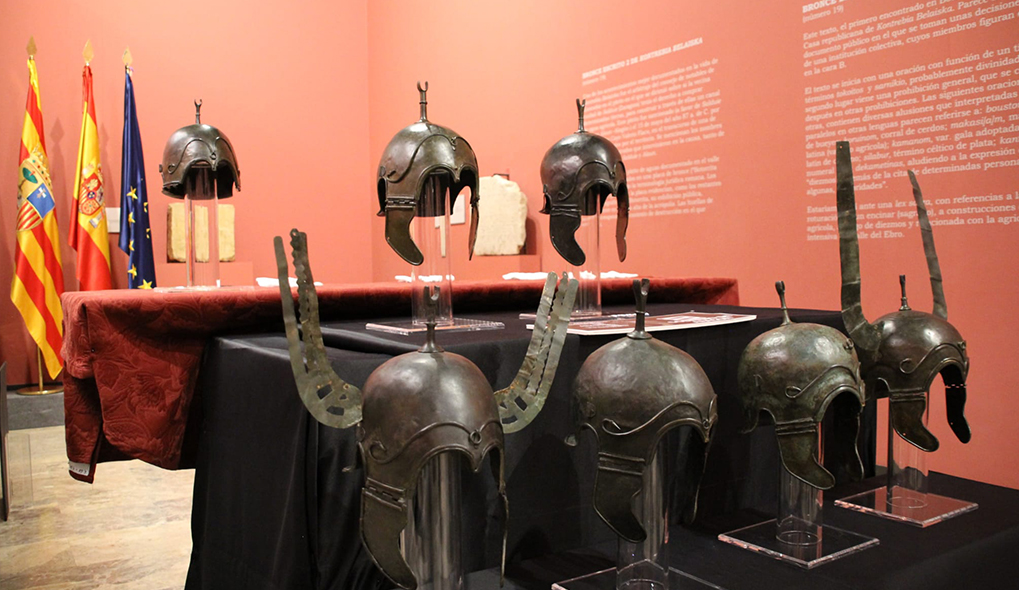Francisco Romeo Marugán.
Government of Aragon
Head of the Cultural Heritage Prevention Section
Judicial expert in the Helmet case
On 25 November 1993, the Government of Aragon received news from the commission of an alleged plunder with a bulldozer at a site near the town of Aranda de Moncayo, in Aragon. Thus, began a long journey which, for the moment, has ended with the return of part of the helmets taken from Aragonese heritage.
After the inspection, the Guardia Civil was informed of the facts. However, it was not until October 2010 that this case was reactivated, when the Government of Aragon became aware of the existence of a batch of Celtiberian weapons, probably from Aranda del Moncayo, which were awaiting auction in Germany. These goods were allegedly acquired during the 1990s by the German collector Axel Guttmann, and passed to an auction house after his death. This means that the investigations have been reopened.
On 13 February 2013, the Guardia Civil informed of the arrest of the alleged perpetrator of the looting, and the seizure of more than 6.835 archaeological pieces and up to six pieces of metal detection equipment. The investigations continued and on 30 July 2013, three other properties belonging to a second defendant were thoroughly searched. As a result of this operation, 2.429 archaeological objects were seized and the accused was arrested.
The Court commissioned the Government of Aragon to carry out an expert report on the seized materials. It ordered the determination, if possible, of the type, quantity and economic valuation of the pieces taken from the site, as well as the damage caused to the site, and to determine whether or not this site is the origin of the auctioned pieces. To this end, the following actions were carried out:
- Study, identification, inventory, graphic documentation and appraisal of all the pieces seized in operations Helmet I and Helmet II.
- Detailed inspection of the surface and surroundings of the Celtiberian city of Aratis.
- Delimitation and detailed study of the surface remains of the archaeological site.
- Carrying out an archaeological intervention in the area affected by the illegal land clearance inside Aratis.
- Drafting of an expert report of more than 11,000 pages with all this data.
This expert report was one of the key elements in the legal proceedings, which ended up attesting the plundering as a proven fact.
This detailed study made it possible to find the necessary clues to bring the judicial process to a successful conclusion; apart from locating several forgeries, it was possible to connect two fragments of the same piece, an accessory disc of a kardiophylakes; a small fragment was seized in Helmet I and another in Helmet II, unequivocally connecting the two defendants to each other, who claimed not to know each other at all.
In both operations, fragments of Hispano-Chalcidic helmets were located, as well as fragments of an Aguilar de Anguita type helmet and other types from the Iberian Peninsula. The fact that fragments of Hispano-Chalcidic helmets were found in both repertoires is another element that allows us to relate them to each other, given the exceptional nature of this type of piece. All these elements appear fragmented, with abundant earth covering them and, in some cases such as a paragnatide, folded on themselves. These pieces may have come from necropolises or shrines.
In parallel to the work on the material, work was carried out directly on the archaeological site of the city of Aratis, in the area affected by the earthworks carried out in 1993, in order to prove the damage suffered by the site, quantify it and determine the reasons for these earthworks in particular.
In the excavated area it was possible to prove the commission of the crime and the remains of a Celtiberian necropolis were located, badly affected by the digging machine; the motive and reason for the plundering in this area, as it is in these contexts where metal objects and weapons, archaeological materials of high economic value, frequently appear.
The trial took place at the Provincial Court of Zaragoza on 2 and 3 April 2017. The plundering, the damage caused to the site and the role of the second detainee as receiver and intermediary have been proven. The sentence was published on 17 July 2018:
- First arrested and plunderer: 6 years imprisonment and 235,000 € fine.
- Second detainee, receiver and intermediary: 3 years imprisonment and 120,000 € fine.
The seized items became the property of the state and, therefore, of the Aragon Autonomous Community by delegation.
The sentence is appealed before the Supreme Court. The judgement, published in July 200, upheld the charges, although the sentence of the second detainee was somewhat reduced. The first was not sentenced to prison as he died in 2019.
Mr. Christian Levett, who owned a batch of seven helmets, decided, in a commendable gesture, to return them free of charge to their place of origin, entering into talks to that end before the first judgment. The talks bore fruit and the helmets returned to the Zaragoza Museum in December 2019.
An extensive study has been carried out on these helmets, which will be published in a book of more than 300 pages, coordinated by Raimon Graells and Ricardo González: The return of the Celtiberian helmets from Aratis. An unfinished story, which will see the light of day and will be presented in the next few days. The book contains an exhaustive analysis of the pieces, with X-rays and metallographic analysis, and a detailed analysis of the whole operation, which has had an almost happy ending. However, we still do not know how many helmets left the Celtiberian city of Aratis, the looter has taken the circumstances of their discovery to his grave, and an unknown number of helmets and other pieces remain in the shadows of the illicit market, deprived of their archaeological context.
The loss to heritage has been tremendous. But, fortunately, it has not gone unpunished.

